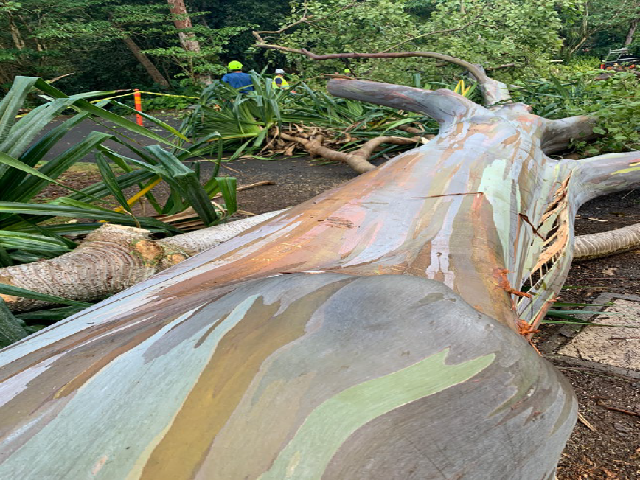By Christopher Buehler, Horticultural Technician, Waimea Valley on Oahu’s North Shore
It’s been a wet and windy winter in Waimea Valley this 2020, and thanks to one particularly blustery evening this February there are a number of fallen branches and uprooted trees in the botanical collection. The most obvious of these casualties is one that has never failed to delight and impress visitors to Waimea Valley as they approach the first bridge to
begin their hike. The fancifully-colored bark of Eucalyptus deglupta, commonly called “Mindanao Gum” or “Rainbow Eucalyptus” makes it one of the rockstars in the world of ornamental trees. With gradations ranging from blue to yellow, to orange, then red and finally brown, as it oxidizes with age, the old bark naturally peels off revealing the bright-green, new bark underneath, creating some truly striking contrasts. Our 80 ft. tall specimen was the valley’s only example of E. deglupta, and has been a favorite subject for countless photos and selfies ever since it was planted in 1993. Sadly, the recent wind damage to its limbs and the resulting vertical split that appeared within its main trunk, required it to be felled
for general safety. Now the only remaining evidence of its mighty existence is simply the first 30 ft. of its lower trunk and a pile of soggy, orange wood chips that lie next to its 4 ft. diameter stump. A lamentable sight indeed- so let us have a moment of quiet reflection as we appreciate its past glory.
The Mindanao Gum, though it is remarkable for a number of reasons, is not an especially uncommon tree to come across in warm climates of the world. It can be found planted as an ornamental in southern California, Texas and Florida, not to mention many places in Hawaii. A fine specimen, found in the Wahiawa Botanical Garden, with a “state exceptional tree” designation, comes to mind. Waimea is searching for a replacement tree to be planted in the valley. The Rainbow Euc. is very distinct however, in
that it’s one of only fourteen eucalyptus species that is not native to Australia. Instead, being a native to Papua New Guinea, Solomon Islands, Indonesia and Mindanao, E. deglupta is accustomed to growing in a tropical rainforest environment, and vying for light amongst other fast-growing, forest-giants.
Although many of the 800 or so other eucalyptus species are also notable for growing to enormous heights, the Rainbow Eucalyptus attains its height
significantly more quickly. Average growth rates of E. deglupta have been reported to be as high as 22 feet per year, with some groves achieving 180 feet in just 14 years! This is one of, if not the, fastest growth rate recorded for any hardwood tree species. Which is why it is planted in Philippine tree plantations. Being a eucalyptus, the heart-wood is evenly-colored and imbued with antimicrobial and insecticidal tannins and phenols, so the wood from older trees are naturally resistant to rot, and prized for lumber and furniture. And because they grow so quickly, young ones are used for paper pulp. In fact, the absence of this fixture to the valley’s entrance highlights a common theme when it comes to the appreciation and conservation of nature. That spectacular Rainbow Gum was planted just 8 ft. away from another tree, an eleven year old accession of a not so photogenic Pereskia quisqueyana (“Bayahibe Rose”) that then had to adjust
to a life in the shadow of its more popular neighbor. This small tree was given its common name because it sports very lovely large pink flowers resembling roses, and at the time of its discovery in 1977 it was located only in one place on earth, Bayahibe village in the Dominican Republic. There were twelve plants known at the time, located in one church yard of that town, and they were all male. Later a tiny population of females
was located, and conservation efforts were undertaken, but soon after, the owner of the land that sheltered the females, much like everyone else had done before, cut every single one down because of the thorns. Pereskia quisqueyana was later named the national flower of Dominican Republic, but it is a highly endangered species, and Waimea Botanical Garden was
incredibly fortunate to receive one in 1983, and help in the conservation of this extremely rare plant.
Although the beauty of “Bayahibe Rose” may not be as easy to appreciate, it is in fact no less an extraordinary species than E. deglupta, in that it is
one of the very few out of thousands of cactus species that has true, non-succulent leaves. It is a very primitive example of the cactus family and believed to look much like the common ancestor of all cacti, from before the family diverged some 30 million years ago into a separate lineage found only in the Americas. They also reportedly have edible and delicious
fruit, but unfortunately our only accession is male so we shall never get a taste from it. But now that our wickedly spiky little friend is able to enjoy
the open freedom of full-sun once again, just in time for summer, we may expect to see a new flush of growth and blooms, and maybe, just maybe, this long unnoticed treasure may appear in a selfie or two.



